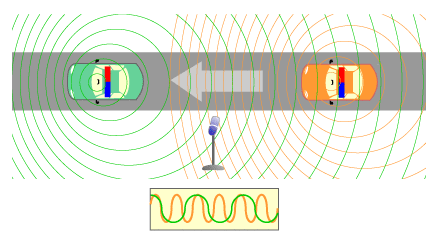Sound Doppler Shift Calculator
he Doppler Effect calculator for sound waves calculates the observed frequency and wavelength of a sound wave given the source frequency, speed of source, and speed of sound in the air.
This content is licensed under Creative Commons Attribution/Share-Alike License 3.0 (Unported). That means you may freely redistribute or modify this content under the same license conditions and must attribute the original author by placing a hyperlink from your site to this work https://planetcalc.com/2351/. Also, please do not modify any references to the original work (if any) contained in this content.
The user can input the source frequency in Hertz (Hz), the speed of the source in meters per second (m/s), and the speed of sound in air in meters per second (m/s).
The calculator uses the formula for the Doppler effect (can be found below the calculator), which relates the observed frequency to the source frequency, speed of the source, and speed of sound in air. The formula accounts for the change in frequency due to the relative motion of the source and the observer, resulting in either a higher or lower pitch. A negative speed of the source indicates that it is moving away from the observer.
The Doppler Effect

The Doppler effect is the change in frequency of a wave for an observer moving relative to its source. It is commonly heard when a vehicle sounding a siren or horn approaches, passes and moves away from an observer. The received frequency is higher (compared to the emitted frequency) during the approach, it is identical at the instant of passing by, and it is lower during the moving away.
The relative changes in frequency can be explained as follows. When the source of the waves is moving toward the observer, each successive wave crest is emitted from a position closer to the observer than the previous wave. Therefore each wave takes slightly less time to reach the observer than the previous wave. Therefore the time between the arrival of successive wave crests at the observer is reduced, causing an increase in the frequency. While they are traveling, the distance between successive wavefronts is reduced; so the waves "bunch together". Conversely, if the source of waves is moving away from the observer, each wave is emitted from a position farther from the observer than the previous wave, so the arrival time between successive waves is increased, reducing the frequency. The distance between successive wavefronts is increased, so the waves "spread out".
The Doppler effect for sound can be expressed as follows:
Frequency change
Wavelength change
For the approaching source, the speed v' should be negative; for receding source, speed v' should be positive.
v - the speed of sound in air. By default, it is equal to the speed of sound in the dry air at 20 degrees Centigrade, see Sound Speed in Gases
Comments